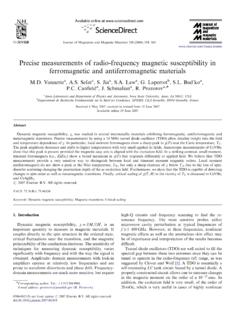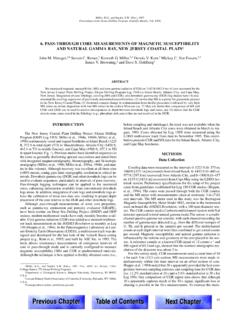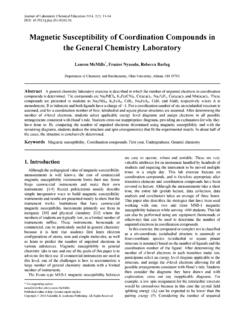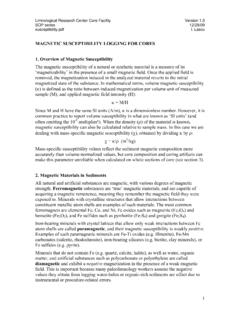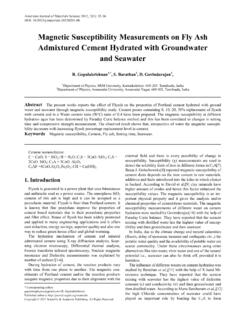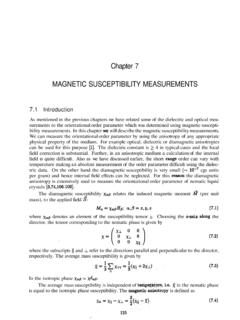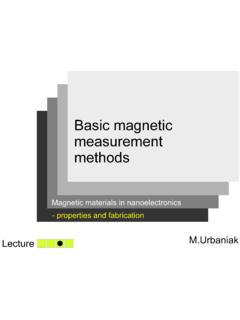Transcription of Preliminary report on magnetic susceptibility …
1 Short communicationUDC report on magnetic susceptibilitymeasurements on rocks within the Zaria granitebatholith, NigeriaS. A. Oniku2, I. B. Osazuwa1and O. C. Meludu21 Dept of Physics, Ahmadu Bello University, Zaria, Nigeria2 Dept of Physics, Federal University of Technology, Yola, NigeriaReceived 23 January 2008, in final form 21 October 2008 Low field magnetic susceptibility measurements have been carried outwithin the Zaria granite batholith. The result has shown that magnetic sus-ceptibility within the batholith varies between 29 10 6SI to 3506 10 6SI,with an average value of 684 10 6SI. The large variation in the measuredvalues of the susceptibility is as a result of large variation of magnetic mineralcontent within an outcrop and the diversity of rock types within individualsuite. Thin section observation of representative samples shows the majormineral to be feldspar, quartz and biotite, while magnetite, ilmenite and he-matite occur as trace minerals.
2 The frequency distribution shows a bimodaldistribution, which is typical of granites due to a low-k peak for paramagneticdominated specimens and high-k peak for magnetite/hematite dominated spe-cimens. The occurrence of hematite and ilmenite may be due to the alterationof magnetic susceptibility , paramagnetic, magnetite, Zaria, granite,batholith1. IntroductionThe magnetic properties describe the behavior of any substance under theinfluence of magnetic field. The magnetic properties of rocks arise from themagnetic properties of the constituent mineral grains and crystals. Typically,only a small fraction of the rock consists of magnetic minerals, and hence thissmall portion determines the magnetic properties and the magnetization ofthe rock as a magnetic properties within a rock type can be quite variable (Car-michael, 1989) depending on chemical inhomogenity, depositional and/or crys-tallization, and post-deformational conditions.
3 The mineral contribution toGEOFIZIKA VOL. 25 No. 2 2008the magnetic susceptibility of a rock has been widely given in literature ( and Oldfield, 1986; Lowrie, 1990; Sch n, 1996). The values of mag-netic susceptibility depend on the grain size, the presence of minute crystallattice, such as dislocations, lattice vacancies, impurities, etc., and an amountof iron ore in a sample. magnetic susceptibility analyses found various applica-tions in different fields of geophysics including geophysical prospecting, min-eral exploration, palaeomagnetism, archaeology, rock magnetism and environ-mental the aim of this research work is to determine the magnetic sus-ceptibility of rocks within the study area, and to identify magnetic mineralspresent in the samples contributing to the magnetic susceptibility . The database for magnetic susceptibility values for various types of rocks found in theZaria granite batholith will be made available through the Advanced Geophys-ical Research Laboratories, Department of Physics, Ahmadu Bello University,Zaria.
4 These data will mainly be used as supportive information for the inter-pretation of airborne aeromagnetic geophysical data within the studied Geological settings, rock types and structuresThe study area (Figure 1) lies between latitude 11 00 N and 11 15 N andlongitudes 7 38 E and 7 46 E covering some parts of the Zaria granitebatholith. The Zaria Granite Batholith belongs to a suite of syn to late tectonicgranites and granodiorites that marked the intrusive phase of the late Pre-Cam-brian to early Paleozoic Pan African orogeny in Nigeria (McCurry, 1973). Thesegranites intruded low grade metasediments and gneisses and were collectivelycalled Older Granite to distinguish them from Mesozoic Younger Granites (Falconer, 1911) of the Jos Plateau and surrounding Pan African orogeny was dated 850 to 467 Ma and the Older Granites618 to 467 Ma (Grant, 1969) using the Rb-Sr method. Ogezi (1977) used thesame method to date a suite of aplite/pegmatite, medium to fine grained, andpophyritic rocks where he obtained an age of 500 Ma and the porphyritic mainrock as the host to other rocks 790 Ma.
5 Ogezi (1977) concluded that the intru-sion of the older granites must have started much earlier than main rock unit of the batholith is coarse porphyritic biotite granitewhich is distinctly foliated in the field. The foliation is broadly orientednorth-south and marked by sub parallel alignment of elongated and closelypacked feldspar phenocryst, mainly microcline and a corresponding preferredorientation of biotite mica. Xenolith of gneisses and micro- as well as maficclots in various stages of digestion also occur in the rock. These bodies con-form in orientation to the general foliation trend. One variant of the granitecan be found exhibiting a less distinct foliation most probably due to sparsedistribution of the feldspar A. ONIKU ET AL.: Preliminary report ON magnetic ..Close to the margin of the batholith, the granite tends to become rathergranodioritic. The type locality is the River Kubani valley exposure of thewestern boundary of the batholith near Ahmadu Bello University (ABU) maincampus.
6 At this point, the batholith is in contact with local basement schistand there is an interbanding between the granite and the host schist. Theseinterbanded rocks dip uniformly at 56oto the west. A similar phenomenon wasreported by Webb (1972) in another contact area in the north near Microscopic description and trace minerals identificationThe petrogenesis of the Zaria biotite granite had been reported by Ike(1974). The porphyritic biotite granites were intruded under the control ofpreexisting structures in the gneissic basement, already dictated by the pre-vailing Pan African orogeny (618 480 ) whose culmination and warningGEOFIZIKA, VOL. 25, NO. 2, 2008, 203 213205 Figure map of the Zaria granite batholith showing the rock exposures marked by the intrusion of the Older Granites. Therefore, according toIke (1974), their concordance with the basement structures does not make theolder granites products of in situ studies of each of the rock units were carried out during thecourse of this research.
7 This was done by observing the thin sections of some ofthe representative samples under reflected light. The study revealed that por-phyritic biotite granite contains essentially microcline, plagioclase, quartz, bio-tite and orthoclase feldspar with microcline and quartz predominating. Themicrocline crystals are clear and have grain sizes of 2 20 mm in length. Inclu-sions of plagioclase are common in the microcline. Quartz occurs both as phe-nocryst and aggregates in the ground mass, the crystals rarely exceed 2 mm indiameter. There are two varieties of plagioclase phenocrysts: those that occurinterstitial to quartz and biotite and those that are enclosed by microcline. Thebiotites occur as brown laths oriented in one direction accounting for the folia-tion observed within the rock. Orthoclase crystals are few and they occur as in-clusion within the microcline phenocrysts. Few brown flakes of chlorite formeddue to alteration of biotite caused by insipient weathering were medium to coarse grained biotite granite consists of crystals of feld-spars, microcline, orthoclase, oligoclase together with quartz and biotite.
8 Ac-cessory minerals include zircon, apatite, allanite and magnetite. Secondaryminerals include hematite, chlorite and clay A. ONIKU ET AL.: Preliminary report ON magnetic ..Table 1: Description of samples and trace minerals extracted from decomposed granites of theZaria unitdescriptionHeavy mineralassemblage recoveredJim Harrison granitepavementAcoarse-graind porphyriticbiotite granitemagnetite, trace ilmenite,zircon and biotiteDan Magaji quarryBcoarse grained grainedfoliated biotite granitemagnetite, zircon, ilmeniteZango granite exposure Cmedium grained foliatedbiotite graniteilmenite, magnetite, hematite,biotite, trace tourmalineAviation site II quarry Dcoarse grained biotitegranitemagnetite, ilmenite, biotite,zircon, hematiteKufena HillEfoliated medium grainedgraniteilmenite, magnetite, garnet,biotite and hematiteJos road (Panzazzaugranite)Fcoarse grained pinkfeldspar granitemagnetite, hematite, ilmenite,zircon and biotiteHanwa graniteGcoarse grained granitemagnetite, biotite, ilmenite,zircon, hematiteBasawa road granitepavementHcoarse grained foliatedbiotite graniteilmenite, magnetite, biotiteand tourmalineMicroscopically, the microgranite essentially contains quartz, plagioclaseand mineral analysis was carried out on eight samples of decomposedgranite collected at different locations across the Zaria granite batholith forthe purpose of the above study.
9 One kilogram of the decomposed granite wascollected from each site and the trace minerals were separated using handpanning technique. The disaggregated samples were placed inside a prospec-tor s pan and then washed with stream water. During the washing processlight minerals such as quartz, decomposed feldspars, some biotite and chloritewere reduced considerably. The residue was mainly an assemblage of heavytrace minerals with some grains of quartz and feldspars as impurities. Theresidue was hand picked under the binocular method for the identification of the trace minerals was by observingthe properties of each mineral such as color, crystal shape and cleavages usingthe binocular microscope and hand lens. The samples and the heavy mineralsseparated are described in Table Principle and measurement of magnetic susceptibilityMagnetic susceptibility is the degree of magnetization of a material in re-sponse to an applied magnetic field.
10 The volume magnetic susceptibility , rep-resented by the symbolKis defined by the relationshipM=KHwhere,Mis the magnetization of the material (the magnetic dipole moment perunit volume), measured in amperes per meter, andHis the applied field, also measured in amperes per quantities are measured in SI unitsThe magnetic inductionBis related toHby the relationshipwhere 0is the permeability of free space(4 10 7 Henry/m), and is the rela-tive permeability of the positive, then (1+K) greater than 1 and the material is called para- magnetic . In this case, the magnetic field is strengthened by the presence ofthe material. Alternatively, ifKis negative, then (1+K) less than 1, and thematerial is diamagnetic. As a result, the magnetic field is weakened in thepresence of the contributions at low field to magnetic susceptibility are summed up asshown (Rochette, 1994).GEOFIZIKA, VOL. 25, NO. 2, 2008, 203 213207()()001 Kmmm=+=+=BHMHHKlf=Kd+Kp+Kaf+Kfwhere the successive right-hand terms are the diamagnetic, paramagnetic,antiferromagnetic and ferromagnetic response of the sample.

